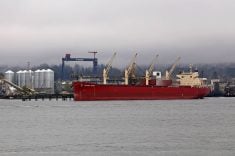The cost of moving grain through the St. Lawrence Seaway has to be
reduced, and that could involve closing some terminal elevators, says
the chief executive officer of the Canadian Wheat Board.
In the text of a presentation made at a recent conference of Canadian
and U.S. shipowners in Florida, Greg Arason said seaway users must find
ways to make the system more competitive if they want to maintain or
increase grain movement through the eastern waterway.
Read Also

StatCan stands by its model-based crop forecast
Statistics Canada’s model-based production estimates are under scrutiny, but agency says it is confident in the results.
“Is it possible that the viability of the seaway could be better
assured by a smaller number of terminal elevators?” he asked.
It costs farmers roughly $24 more per tonne to ship grain through the
seaway to where it can be loaded onto ocean-going ships, than it costs
to ship to Vancouver. The extra costs are due to vessel freight, St.
Lawrence Seaway authority charges and terminal handling fees.
There are 10 licensed terminal elevators at Thunder Bay. Three are
owned by Agricore United, created by last year’s merger of Agricore and
United Grain Growers, and two by Saskatchewan Wheat Pool.
Arason said fewer terminals could translate into reduced fixed and
operating costs for the terminals that remain, which could in turn mean
lower grain shipping costs and increased volumes.
“We must examine the cost structure of grain movement through the
seaway with similar openness and identify areas where financial
benefits can be generated,” he said.
In an interview, the board’s CEO said everyone with a financial stake
in the seaway, including ship owners and terminal operators, must think
about rationalizing the terminal or transfer elevators that serve the
seaway.
Ed Guest, secretary manager of the Western Grain Elevators Association,
said Arason’s comments seem to be at odds with some of the board’s
actions.
For example, the board bypasses the seaway system by shipping
significant volumes of grain by rail directly to export position on the
lower St. Lawrence River.
The board also has a guaranteed tonnage contract with Mission Terminal,
which began operating at Thunder Bay in 2000.
“I find his message curious,” said Guest. “What the board has done by
signing a contract with a new entrant is to take away tonnes from the
current establishment, spreading the tonnes thinner and making it
tougher for anybody to make money.”
In his speech, Arason suggested a couple of other measures that might
reduce costs and make the seaway more competitive, including more
“direct hit” shipments of cleaned grain from the Prairies to waiting
export vessels and more use of self-unloader vessels for the movement
of grain.
Self-unloaders can unload their cargo directly to a dock-side facility,
or even another vessel, without going through an elevator, thus saving
handling fees.
More than 86 percent of the total tonnage of cargo moved through the
seaway in 2000 was in self-unloaders.
However only 34 percent of grain shipments moved in self-unloaders,
with the rest shipped in conventional bulkers.
Shane Foreman, manager of policy and research for the Canadian
Shipowners Association, said that’s in part a reflection of the
perishable nature of grain. While coal can simply be unloaded and piled
on the ground, grain must be stored in an elevator.
Another factor is that the elevator infrastructure already exists and
that’s how grain has traditionally been shipped and handled.
The volume of grain shipped through the seaway has been declining in
recent years, from 13 million tonnes in 1995 to 7.7 million tonnes in
2000, reflecting an number of factors including smaller crops and fewer
sales to European markets.
















